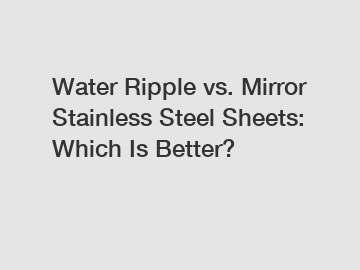How Does Sustainable Fashion Impact the Environment?
Sustainable fashion has emerged as a vital movement in the textile and apparel industry, significantly influencing how we think about clothing and its impact on the planet. The transition from traditional fast fashion to sustainable practices represents a larger cultural shift towards environmental mindfulness, conscious consumerism, and ethical production. But how exactly does sustainable fashion impact the environment? Let's delve into this intricate relationship.
First, it's essential to define what sustainable fashion truly entails. It encompasses the design, sourcing, production, and lifecycle of clothing that prioritizes environmental and social responsibility. Unlike fast fashion, which thrives on cheap materials, quick production cycles, and mass consumption, sustainable fashion emphasizes quality, durability, and using eco-friendly materials. This shift alone has significant ramifications for our planet.
One of the most immediate benefits of sustainable fashion is its reduction in waste. The fast fashion industry is notorious for its throwaway culture; millions of tons of clothing wind up in landfills every year. It’s estimated that in the U.S. alone, around 11 million tons of textiles are discarded annually. Sustainable fashion advocates for quality over quantity, encouraging consumers to invest in timeless pieces that can be worn repeatedly. By extending the lifecycle of garments, we significantly reduce the amount of waste generated, fostering a more circular economy.
Moreover, sustainable fashion often utilizes eco-friendly materials that are less harmful to the environment. Traditional textile production processes consume vast amounts of water and energy, resulting in significant pollution and resource depletion. In contrast, sustainable brands might turn to organic cotton, hemp, or recycled materials, which require fewer resources and are often produced in a manner that minimizes environmental impact. For instance, organic cotton is grown without synthetic pesticides or fertilizers, reducing soil and water contamination, while recycled materials prevent the unnecessary depletion of new resources.
Another critical aspect of sustainable fashion is the reduction of carbon emissions associated with textile production. The fashion industry contributes approximately 10% of global carbon emissions—a figure that is alarming, to say the least. By adopting sustainable practices, brands can reduce their carbon footprint. This involves opting for local production, using renewable energy sources, and implementing energy-efficient manufacturing processes. For consumers, supporting brands that prioritize sustainability means opting for companies that commit to transparency about their emissions and contributions to climate change.
Water usage is another area where sustainable fashion takes a stand. The conventional production of textiles often leads to significant water pollution and scarcity. For instance, the dyeing processes used in fast fashion can involve toxic chemicals that not only harm ecosystems but also risk the health of communities around factories. Sustainable brands focus on innovative techniques like waterless dyeing or natural dyeing methods, drastically reducing their water footprint. Each step towards cleaner processing helps protect vital water resources and maintain ecosystem health.
Related links:Unlocking Efficiency in Custom Plastic Mold Injection
Stainless Hairline 304 vs Other Alloys: Which Is Superior?
How to Choose the Right Threaded Pipe Fittings?
The Benefits of Using Solar-Powered Garden Lights
10 Facts You Should Know about Electric Vehicle Charging
NPT Female Union Elbows: Brass vs. PVC Comparison Guide
How Does Personalized Engraved Wooden Sign Work?
Land use is yet another environmental factor that warrants consideration. The rise of synthetic materials has led to an uptick in land required for fossil fuel extraction, which produces many of the synthetic fibers used in cheap clothing. Sustainable fashion encourages the use of plant-based materials and promotes local sourcing, which helps preserve natural habitats and biodiversity. By prioritizing sourcing practices that respect ecosystems, sustainable brands play a crucial role in combating deforestation, soil erosion, and wildlife disruption.
Additionally, sustainable fashion includes a strong social dimension. Behind many sustainable brands are ethical labor practices that seek to ensure fair wages, safe working conditions, and community development. The fast fashion industry has often thrived on exploitative labor practices, causing harm not only to the environment but also to the very people who make our clothes. By supporting sustainable fashion, consumers are contributing to a more ethical economy—one that values human rights as much as environmental impact.
Ultimately, sustainable fashion invites consumers to be more mindful of their purchasing decisions. The mantra “buy less, choose wisely” encapsulates the ethos of this movement. Consumers are encouraged to seek out brands that align with their values, urging them to think critically about the implications of their purchases. This conscious consumerism can drive significant change, encouraging brands to adopt more sustainable practices and reduce their environmental footprints.
In conclusion, the impact of sustainable fashion on the environment is profound and multifaceted. It addresses critical issues like waste reduction, resource conservation, carbon emissions, water usage, and ethical labor practices. As consumers, we hold immense power in shaping the direction of the fashion industry through our choices. By supporting sustainable fashion, we not only invest in quality garments but also become stewards of the environment. Together, we can pave the way for a more sustainable future—one stitch at a time.
If you are looking for more details, kindly visit custom plastic mold injection, china motor part mould, china plastic injection molding manufacturer llc.
Related links:4 Tips to Select a Durable Rigid Grooved Coupling
Ultimate Guide to GI Fittings: Types, Uses, and Best Practices
How Does Engraving Wooden Coasters Work?
10 Questions You Should Know About Choosing the Right Stainless Steel Plate for Decoration
Unlocking Water Ripple Steel: Benefits & Applications Explained
How to Enhance Spaces with Water Ripple Steel?
How to Choose Ripple Stainless Steel Sheet Effectively?









